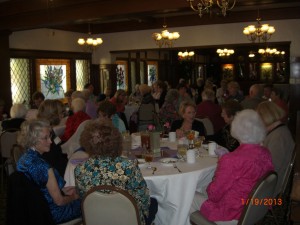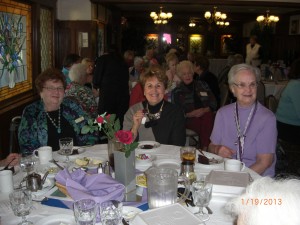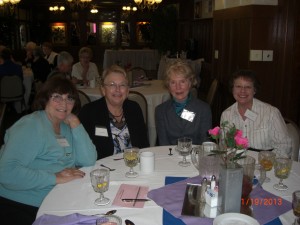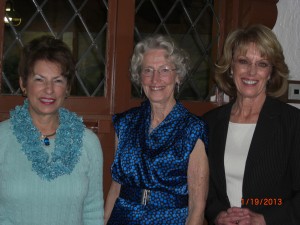


 January is International Month for our AAUW Santa Maria Branch. This year, to honor the International theme, we were pleased to have Marj Sewell of San Luis Obispo County come share her story of “Growing Up Around Hearst Castle.” For many of us, living on the Central Coast of California, Hearst Castle, San Simeon, is a “signature landmark”, like Morro Bay Rock, or the Historical Santa Maria Inn, with an abundant array of personal stories shared by locals and visitors alike. To the world, Hearst Castle is a tourist attraction unique to the California Coast. And to hear the stories from one who lived there, who experienced that world firsthand, is a special moment indeed!! Accompanied by her personal slideshow, Marj Sewell shared her memories of living “at the Ranch”, going to school in a “one-room schoolhouse” on the Ranch, encountering the many wild animals that Wm. Randolph Hearst ensconced on his Ranch, including the llamas and emu that would greet cars at the gates along the way to the top. Ms. Sewell shared many humorous and poignant moments, making many of us wish we could hear more stories.
January is International Month for our AAUW Santa Maria Branch. This year, to honor the International theme, we were pleased to have Marj Sewell of San Luis Obispo County come share her story of “Growing Up Around Hearst Castle.” For many of us, living on the Central Coast of California, Hearst Castle, San Simeon, is a “signature landmark”, like Morro Bay Rock, or the Historical Santa Maria Inn, with an abundant array of personal stories shared by locals and visitors alike. To the world, Hearst Castle is a tourist attraction unique to the California Coast. And to hear the stories from one who lived there, who experienced that world firsthand, is a special moment indeed!! Accompanied by her personal slideshow, Marj Sewell shared her memories of living “at the Ranch”, going to school in a “one-room schoolhouse” on the Ranch, encountering the many wild animals that Wm. Randolph Hearst ensconced on his Ranch, including the llamas and emu that would greet cars at the gates along the way to the top. Ms. Sewell shared many humorous and poignant moments, making many of us wish we could hear more stories.
Over 40 people gathered for a lovely luncheon in the Kent Room of the Historic Santa Maria Inn. We are pleased to have so many members and guests join us for this interesting presentation. And we would like to thank the Historic Santa Maria Staff for the good service and support during a “computer” crisis.
Please enjoy the article below that appeared in the “Santa Maria Sun” prior to Marj Sewell’s presentation at our luncheon.
Hearst Castle: A Firsthand History
by AAUW
The following article is from THE SANTA MARIA SUN, Volume 13, Issue 44, January 11, 2013. Our sincere thanks to Joe Payne for such a nice article. The original article can be viewed at their website:
http://www.santamariasun.com/art/9213/firsthand-history/
Firsthand history
The American Association of University Women welcomes Marj Sewell and her program about her life at Hearst Castle
BY JOE PAYNE
Hearst Castle has been a landmark on the Central Coast ever since it was completed in the 1940s. But it wasn’t until 1957, when the location was donated to the state of California by the Hearst Corporation, that it became a national historical landmark.
Before you visit the grand location, you should know that there are a few faux pas that should be avoided—and only an expert boasting a wealth of experience with Hearst Castle could help you avoid them.
“First, we never call it the castle,” said Marj Sewell. “When Mr. Hearst invited you to come, he called it ‘The Ranch.’ He never called it the castle.”
Sewell provides an insightful outlook on William Randolph Hearst and his massive home. She grew up in San Simeon, and she spent much of her childhood on the Hearst grounds.
She’ll be sharing her knowledge and experience for a program in Santa Maria made possible by the American Association of University Women. Lynda Snodgrass, the program co-chair for the association, is responsible for booking Sewell for a talk.
“My husband is in the living history program at Hearst Castle with Marj,” Snodgrass said, “and we received a notice that Marj was going to put on a program, but we missed it! And as the program co-chair, I was thinking of something interesting for our members to enjoy.”
The association programs talks about various topics for members and the community alike. This upcoming talk, Snodgrass said, serves a dual purpose.
“It educates our members and makes them more aware of what’s going on in the community,” she said. “But it’s a social program as well as an educational one.”
Sewell’s experience at Hearst Castle began in childhood. Her parents moved to the United States from Australia and found themselves both working at Hearst Castle—her father as the gardener, and her mother as cook. From an early age, Sewell spent much time exploring the grounds.
“I remember walking when it was fruiting season,” she said, “and we would walk along this trail—it’s a mile and a quarter long—and it had every kind of fruit, and we would just go along there and eat whatever we wanted. During the summer, my brother would hand water all those trees because, of course, back then everything had to be hand watered.”
Befriending the head housekeeper also helped Sewell explore nearly every room of the mansion as a child, which gives her a rich knowledge of the location—knowledge she uses today when she volunteers at Hearst Castle. Sewell is part of the “Living History Program” there, which is a seasonal night tour of the mansion featuring volunteers in period dress, enjoying the accoutrements of the stunning home.
“All the docents dress in 1930s dress, you know: vintage clothes,” Sewell said. “I make most of mine. I find vintage patterns.”
Sewell is one of the only “Living History Program” volunteers allowed to wander the grounds as she wishes, whereas most are limited to one area or activity. She uses this freedom to occupy her favorite spot.
“What I do mostly is sit in one of the cottages, Casa del Mar,” she said, “and I sit in the ladies bathroom at the vanity and I buff my nails. It’s quite fun.”
Sewell’s program isn’t just limited to Hearst Castle; it spreads into San Simeon itself. There was, after all, a community outside of the giant mansion. Sewell attended school in San Simeon along with many other children of Hearst Castle employees.
“When I was growing up here, there was an aura of Hearst that you wouldn’t believe,” she said. “It just overshadowed everything over here. He wasn’t just a large land owner, but he was a very popular landlord and employer.”
But even Sewell will say that nothing——her talk included—compares to visiting Hearst Castle.
“They’re missing out on an experience,” she said of people who don’t see it for themselves, “and the experience is that you will see something that you wouldn’t see any place else.”
To solidify that it isn’t truly a castle, Sewell explained that the design, by Julia Morgan, is that of a great cathedral surrounded by smaller cottages, as in a medieval village.
“Even Europeans are impressed with it,” she said. “You can’t compare this to a castle in France. This is a man’s home, a stately home.”
Arts Editor Joe Payne could not find a moat. Contact him at jpayne@santamariasun.com.
